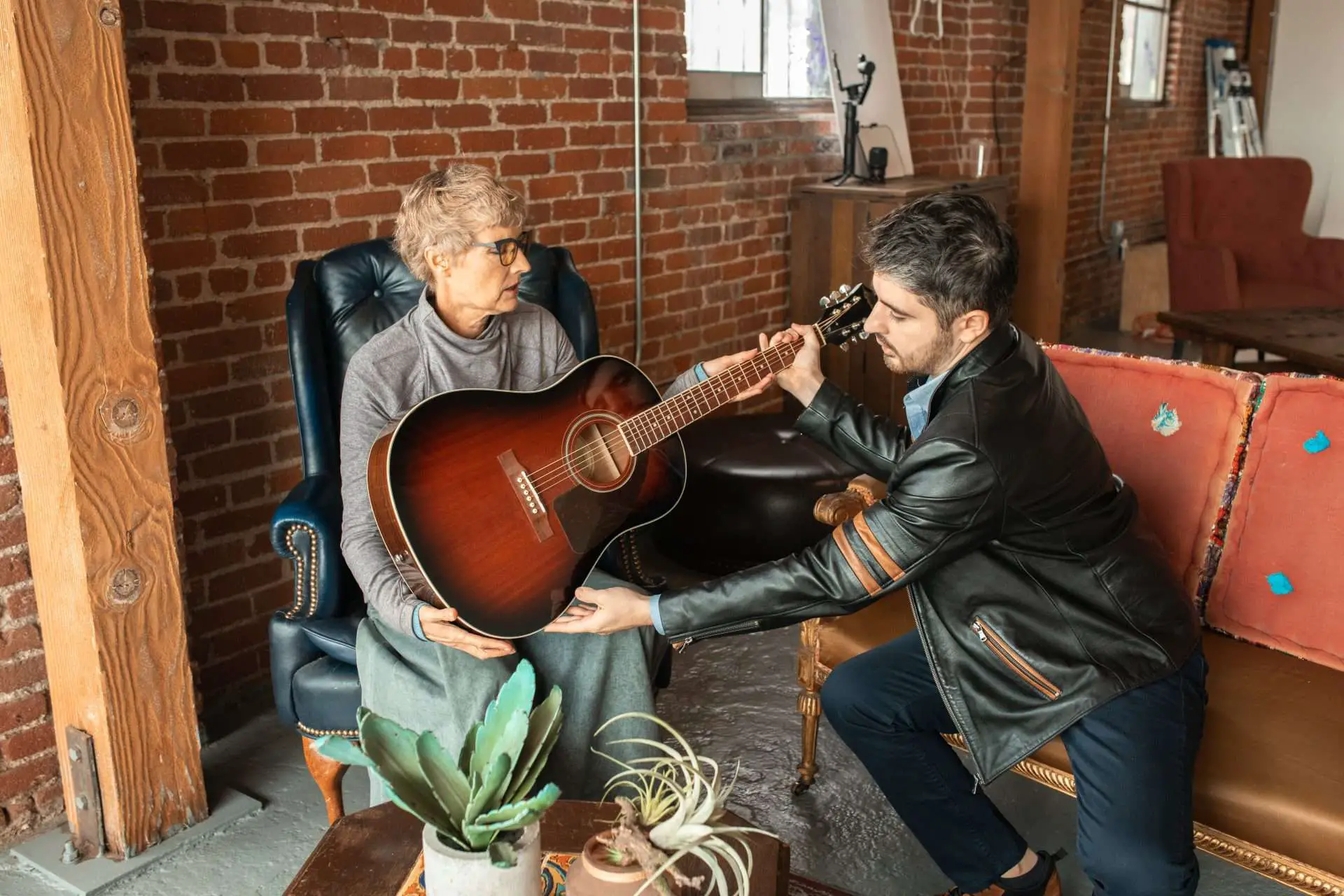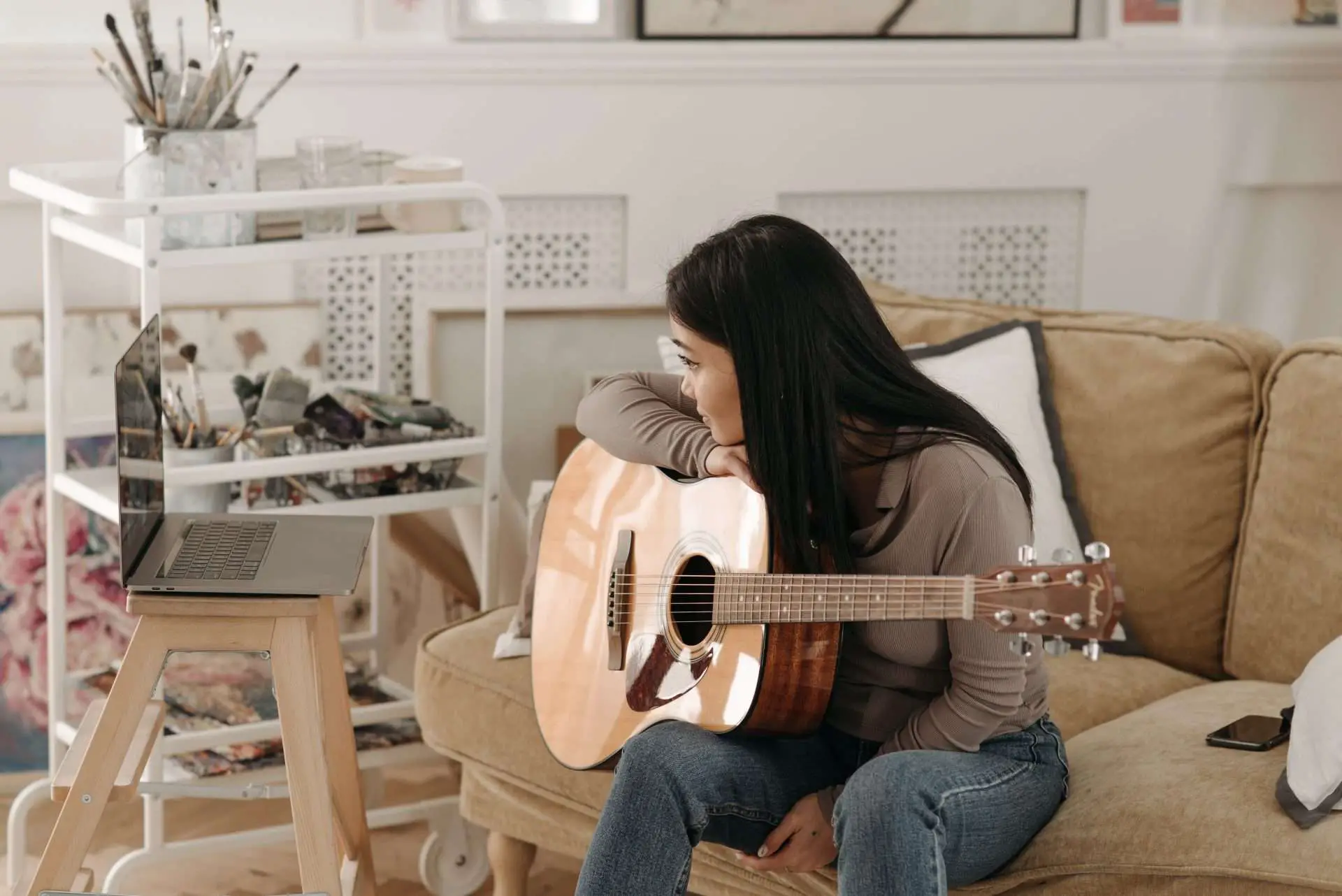Learning guitar as an adult is not only achievable—it can be an incredibly rewarding journey. Whether you’ve always dreamed of playing your favorite songs or want to explore a new creative outlet, the idea that you’re too old to start is simply a myth.
This guide is designed to provide practical, step-by-step advice for those ready to embark on this musical adventure. By focusing on actionable strategies and clear milestones, you’ll find that learning to play the guitar is both manageable and enjoyable.
Embrace the challenge with the understanding that every expert was once a beginner. Let’s get started on building your musical skills and confidence.
Key Takeaways:
- Learning guitar as an adult is completely achievable and comes with unique advantages like discipline, focus, and real-world experience.
- Choosing the right guitar, setting realistic goals, and following a structured practice routine are key to steady progress.
- A mix of self-teaching through YouTube and online courses, combined with occasional private lessons, offers a flexible and effective learning approach.
- Common myths about adult learning, such as being “too old” to start, are false—consistent effort matters far more than age.
- The true value of learning guitar lies not just in technical skill, but in the joy of personal growth, creativity, and lifelong learning.

Getting Started: Choosing the Right Guitar
When beginning your guitar journey, selecting the right instrument is essential for steady progress and enjoyment. A well-chosen guitar can boost your confidence and help you stay committed to practice.
Types of Guitars for Adult Learners
- Acoustic Guitars: Ideal for beginners, acoustics are straightforward and versatile, making them perfect for a variety of musical styles.
- Electric Guitars: If you’re drawn to rock, blues, or a more modern sound, electric guitars offer features like easier playability and diverse tone options.
- Classical Guitars: With nylon strings that are gentler on the fingers, classical guitars are a good choice for those interested in fingerstyle or classical music.
Factors to Consider When Buying a Guitar
- Budget: Determine your price range. Entry-level guitars are affordable and sufficient for starting out, while investing more later can provide additional features and durability.
- Comfort and Playability: Ensure the guitar’s size, weight, and neck profile suit your body type and hand size. Visit a store to test different models if possible.
- Sound and Genre: Choose a guitar that matches the musical style you’re passionate about; the right tone will keep you motivated to practice.
- Quality and Reviews: Look for instruments with good build quality and reliable reviews from other adult learners to ensure you’re making a solid investment.
This straightforward approach to choosing your first guitar will help you build a foundation for success without overwhelming you with technical details.

Understanding the Fundamentals: Music Theory for Adults
A solid grasp of basic music theory can greatly enhance your guitar learning experience. It doesn’t require hours of study—just a focused approach on the essentials that will directly apply to your playing.
Essential Music Theory Concepts
Start with the basics: understand how notes form scales and chords. Learn key signatures, intervals, and rhythm patterns to give structure to your playing. A good approach is to focus on the major and minor scales, as they form the foundation of most music. This targeted learning will make practice sessions more meaningful and help you recognize patterns in songs you enjoy.
Applying Theory to Practice
Integrate theory into your daily practice by applying what you learn directly to your guitar. For example, take a simple song and identify its chords and scale patterns. Experiment with creating your own chord progressions or improvising over a backing track. This hands-on approach solidifies your theoretical knowledge and builds your confidence as a guitarist.

Establishing Effective Practice Routines
Developing a solid practice routine is key to steady progress. With a consistent schedule and focused exercises, you can make the most of your practice time without feeling overwhelmed.
Designing a Daily Practice Schedule
Creating a structured practice plan helps you balance skill-building and fun. Here’s a sample daily schedule that you can adapt to your routine:
| Time Slot | Activity | Details |
|---|---|---|
| 10 minutes | Warm-Up Exercises | Finger stretching, simple scales |
| 15 minutes | Chord Practice | Focus on transitioning between two or three chords |
| 15 minutes | Song Practice | Play along with a simple song, focusing on timing |
| 10 minutes | Music Theory Application | Work on scales, chord progressions, or improvisation |
| 10 minutes | Review and Cool Down | Reflect on what worked, note challenges |
Adjust these time blocks based on your available practice time and personal goals.
Techniques to Maintain Motivation
Staying motivated over time is crucial for long-term success. Consider these actionable strategies:
- Set Clear, Achievable Goals: Break down your journey into smaller milestones (e.g., mastering a chord, playing a full song).
- Track Your Progress: Use a practice journal or an app to record improvements and challenges.
- Mix It Up: Vary your practice routine by learning new songs, experimenting with different styles, or occasionally jamming along with backing tracks.
- Join a Community: Engage with fellow learners online or in local groups to share tips, celebrate successes, and overcome obstacles together.
By incorporating these techniques into your daily routine, you can maintain enthusiasm and see continuous improvement in your guitar skills.

Exploring Various Learning Methods
When it comes to learning guitar, there are multiple paths to success. Many adults find that a mix of self-teaching through YouTube videos and online courses, combined with occasional in-person lessons, offers a balanced approach.
Online Courses and Self-Teaching Resources
- YouTube Tutorials:
YouTube is a treasure trove for guitar lessons. You can find channels dedicated to everything from basic chords to advanced solo techniques. The advantage is the flexibility to pause, rewind, and replay sections until you understand the material. - Online Courses and Apps:
Websites and apps like Fender Play & JustinGuitar offer structured lessons and progress tracking, blending video content with interactive exercises to help you monitor your improvement over time.
In addition, we also provide a wealth of resources for beginners, including in-depth music theory lessons on chords, scales, and other essential guitar topics. - Self-Paced Learning:
The self-teaching route allows you to set your own pace and focus on what interests you most. Create a playlist of lessons on specific techniques or genres and organize your practice sessions around these topics.
Private Lessons and Community Workshops
- In-Person Lessons:
Taking lessons with a local instructor can provide personalized feedback and immediate corrections that are sometimes hard to get online. A teacher can help adjust your technique in real-time, which is particularly useful when you’re just starting out. - Blending Methods:
Consider a hybrid approach: use self-teaching methods to cover broad topics and fill in gaps with periodic private lessons. Even one session a month can help ensure you’re on the right track and give you targeted advice on overcoming challenges.
By combining self-teaching with structured guidance, you can tailor your learning experience to your personal needs and schedule, making the journey both flexible and effective.
Addressing Common Misconceptions About Adult Learning
Many potential guitarists hesitate to start learning due to persistent myths about age and learning abilities. However, the evidence shows that adults can not only learn guitar effectively but also bring unique strengths to the learning process.
Debunking Myths About Age and Learning Abilities
- Myth: “I’m too old to learn.”
Studies consistently reveal that adult learners bring discipline, focus, and real-life experience to their practice sessions. Your ability to set clear goals and manage time effectively can accelerate your learning process, making your age a strength rather than a limitation. - Myth: “I’ll never catch up to those who started young.”
While early starters may have a head start, adult learners often have a deeper understanding of their personal learning style and can avoid many of the common pitfalls beginners face. With structured practice and quality resources, you can progress steadily and reach an intermediate level on your own timeline.
Embracing the Unique Advantages of Adult Learners
- Focus and Commitment:
As an adult, you’re likely more motivated by clear goals and practical outcomes. This focus means you’re better prepared to dedicate time and effort to mastering the guitar. - Real-World Experience:
Your life experiences can provide a broader perspective on music. Whether it’s understanding complex rhythms or appreciating the emotional depth of a song, your mature outlook can enrich your playing. - Resourcefulness:
Being self-aware and proactive, you can effectively blend various learning methods—from self-teaching via YouTube and online courses to targeted in-person lessons. At StayTunedGuitar.com, we offer resources that cater to a wide audience, & reinforce that your journey is uniquely yours and filled with opportunities for growth.

Roadmap: From Beginner to Intermediate Guitarist
Mapping out your progress with clear milestones and a structured plan can transform your guitar journey from daunting to doable. This section provides a detailed roadmap that breaks down the progression into achievable stages, ensuring you stay motivated and on track.
Setting Realistic Goals and Benchmarks
Establishing clear, attainable goals is the first step in measuring your progress. Instead of aiming to become a “rock star” overnight, focus on incremental achievements that build your confidence and skill set. Here are some strategies and milestones to consider:
- Short-Term Goals (0-3 months):
- Learn 4-5 basic chords and practice smooth transitions.
- Master simple strumming patterns.
- Play 2-3 beginner-friendly songs.
- Familiarize yourself with essential music theory concepts such as scales and chord construction.
- Mid-Term Goals (3-6 months):
- Introduce barre chords and more complex strumming or fingerpicking patterns.
- Expand your chord library and start combining chords in different progressions.
- Incorporate basic improvisation exercises using scales.
- Start recording your practice sessions to track improvements and identify areas for refinement.
- Long-Term Goals (6-12 months):
- Develop fluidity in chord transitions and incorporate dynamics into your playing.
- Learn intermediate techniques such as hammer-ons, pull-offs, and slides.
- Begin to explore improvisation and solo creation.
- Build a repertoire of at least 10 songs spanning different genres to enhance versatility.
To visualize these milestones, consider the following table:
| Stage | Timeline | Focus Area | Key Milestones |
|---|---|---|---|
| Beginner | 0-3 months | Basic chords, strumming, simple melodies | 4-5 chords, smooth transitions, 2-3 songs, intro to scales |
| Early Intermediate | 3-6 months | Barre chords, fingerpicking, basic improvisation | Expanded chord library, recording sessions, simple solos |
| Intermediate | 6-12 months | Advanced techniques, dynamics, creative expression | Mastery of techniques, 10-song repertoire, effective soloing |
Using this roadmap not only provides a clear vision of where you’re headed but also allows you to celebrate small wins along the way, keeping your motivation high.
Developing a Structured Progression Plan
A structured progression plan is your personalized blueprint for success. It should align with your individual goals, available practice time, and preferred learning style. Here’s how to develop one that works for you:
- Break Down Your Practice Sessions:
- Warm-Up (10 minutes): Start with finger exercises and simple scales to build dexterity.
- Skill Focus (20-30 minutes): Rotate between chord practice, strumming, and technique drills. For example:
- Day 1: Chord transitions and strumming patterns.
- Day 2: Fingerpicking and barre chord practice.
- Day 3: Music theory application (scales and chord construction).
- Song Practice (15-20 minutes): Apply skills by working on a song that challenges you just enough.
- Cool Down (5-10 minutes): Review what you learned and set a small goal for your next session.
- Plan Weekly and Monthly Milestones:
- Weekly Review: At the end of each week, jot down what worked well and what needs improvement. Adjust the following week’s focus based on your progress.
- Monthly Check-In: Evaluate your overall progress against your roadmap milestones. Use a simple checklist or progress chart to visualize improvements. For example:
- Be Flexible and Adaptable:
- Adjust Goals as Needed: If a particular technique is challenging, spend extra sessions on it rather than rushing forward.
- Mix Learning Methods: Combine self-teaching through YouTube or online courses with periodic in-person lessons to receive feedback and refine your technique.
- Incorporate Variety: To avoid burnout, vary your practice routine by alternating between technical drills, creative improvisation, and learning new songs.
By structuring your practice in this way, you create a clear, actionable pathway that not only tracks your progress but also keeps you engaged with a mix of technical skill-building & creative exploration.
This roadmap is designed to evolve with you, ensuring that as you move from beginner to intermediate, your practice remains dynamic and rewarding.
Conclusion
Learning guitar as an adult is more than acquiring a new skill—it’s a journey toward self-discovery and creative expression. This guide has laid out a practical roadmap, yet the deeper takeaway is the power of embracing lifelong learning.
As you navigate your musical path, each chord and scale becomes a reflection of your resilience and adaptability. Remember that your progress is personal and doesn’t need to match anyone else’s timeline. Keep challenging yourself, and let every practice session be a step toward a richer, more fulfilling creative life.
Stay tuned to your journey, and enjoy the process of continuous growth and exploration.
